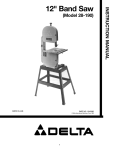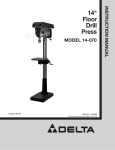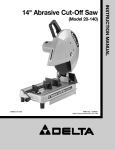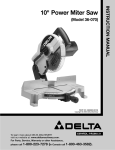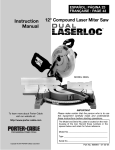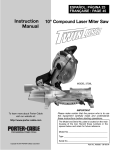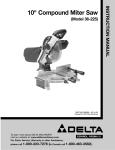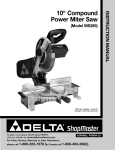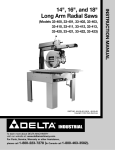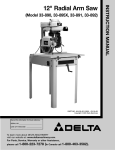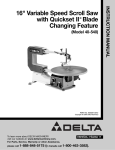Download Delta Sidekick 36-210 Instruction manual
Transcript
TM (Model 36-210) beginning with serial no. K9611 PART NO. 1349945 DATED 4-1-96 © Delta International Machinery Corp. 1996 INSTRUCTION MANUAL Sidekick 10" Compound Miter Box TABLE OF CONTENTS SAFETY RULES..................................................................................................................................................................3 ADDITIONAL SAFETY RULES FOR COMPOUND MITER BOXES....................................................................................4 UNPACKING ......................................................................................................................................................................5 ASSEMBLY INSTRUCTIONS ............................................................................................................................................5 Moving Cuttinghead To The Up Position ..................................................................................................................5 Rotating Table To The 90 Degree Position ................................................................................................................6 Assembling Dust Spout ............................................................................................................................................6 Assembling Dust Bag ................................................................................................................................................6 Assembling Work Clamp............................................................................................................................................6 FASTENING MACHINE TO SUPPORTING SURFACE ......................................................................................................7 EXTENSION CORDS ..........................................................................................................................................................7 CONNECTING SAW TO POWER SOURCE ......................................................................................................................8 Power Connections....................................................................................................................................................8 Motor Specifications ..................................................................................................................................................8 Grounding Instructions ..............................................................................................................................................8 OPERATING CONTROLS Starting And Stopping Machine ................................................................................................................................9 Locking Switch In The “OFF” Position ......................................................................................................................9 Rotating Table For Miter Cutting................................................................................................................................9 Pointer And Scale ....................................................................................................................................................10 Tilting Cuttinghead For Bevel Cutting ....................................................................................................................10 Locking Cuttinghead In The Down Position ............................................................................................................10 Rear Support/Carrying Handle ................................................................................................................................11 ADJUSTMENTS Adjusting Table Positive Stops ................................................................................................................................12 Adjusting 90 And 45 Degree Bevel Stops ..............................................................................................................13 Changing Handle Position ......................................................................................................................................14 Adjusting Downward Travel Of Saw Blade ..............................................................................................................14 Adjusting Blade Parallel To Table Slot ....................................................................................................................15 TYPICAL OPERATIONS AND HELPFUL HINTS ..............................................................................................................15 Auxiliary Wood Fence ..............................................................................................................................................16 General Cutting Operations ....................................................................................................................................16 Cutting Aluminum ....................................................................................................................................................17 Cutting Bowed Material ..........................................................................................................................................17 Cutting Crown Moulding..........................................................................................................................................18 Constructing Work Support Extensions ..................................................................................................................19 MAINTENANCE Changing The Blade ................................................................................................................................................19 Brush Inspection And Replacement ........................................................................................................................20 Delta Building Trades and Home Shop MachineryTwo Year Limited Warranty Delta will repair or replace, at its expense and at its option, any Delta machine, machine part, or machine accessory which in normal use has proven to be defective in workmanship or material, provided that the customer returns the product prepaid to a Delta factory service center or authorized service station with proof of purchase of the product within two years and provides Delta with reasonable opportunity to verify the alleged defect by inspection. Delta may require that electric motors be returned prepaid to a motor manufacturer’s authorized station for inspection and repair or replacement. Delta will not be responsible for any asserted defect which has resulted from normal wear, misuse, abuse or repair or alteration made or specifically authorized by anyone other than an authorized Delta service facility or representative. Under no circumstances will Delta be liable for incidental or consequential damages resulting from defective products. This warranty is Delta’s sole warranty and sets forth the customer’s exclusive remedy, with respect to defective products; all other warranties, express or implied, whether of merchantability, fitness for purpose, or otherwise, are expressly disclaimed by Delta. Printed in U.S.A. 2 SAFETY RULES Woodworking can be dangerous if safe and proper operating procedures are not followed. As with all machinery, there are certain hazards involved with the operation of the product. Using the machine with respect and caution will considerably lessen the possibility of personal injury. However, if normal safety precautions are overlooked or ignored, personal injury to the operator may result. Safety equipment such as guards, push sticks, hold-downs, featherboards, goggles, dust masks and hearing protection can reduce your potential for injury. But even the best guard won’t make up for poor judgment, carelessness or inattention. Always use common sense and exercise caution in the workshop. If a procedure feels dangerous, don’t try it. Figure out an alternative procedure that feels safer. REMEMBER: Your personal safety is your responsibility. This machine was designed for certain applications only. Delta Machinery strongly recommends that this machine not be modified and/or used for any application other than that for which it was designed. If you have any questions relative to a particular application, DO NOT use the machine until you have first contacted Delta to determine if it can or should be performed on the product. DELTA INTERNATIONAL MACHINERY CORP. MANAGER OF TECHNICAL SERVICES 246 ALPHA DRIVE PITTSBURGH, PENNSYLVANIA 15238 (IN CANADA: 644 IMPERIAL ROAD, GUELPH, ONTARIO N1H 6M7) WARNING: FAILURE TO FOLLOW THESE RULES MAY RESULT IN SERIOUS PERSONAL INJURY 15. DON'T OVERREACH. Keep proper footing and balance at all times. 16. MAINTAIN TOOLS IN TOP CONDITION. Keep tools sharp and clean for best and safest performance. Follow instructions for lubricating and changing accessories. 17. DISCONNECT TOOLS before servicing and when changing accessories such as blades, bits, cutters, etc. 18. USE RECOMMENDED ACCESSORIES. The use of accessories or attachments not recommended by Delta may cause hazards or risk of injury to persons. 19. REDUCE THE RISK OF UNINTENTIONAL STARTING. Make sure switch is in “OFF” position before plugging in power cord. 20. NEVER STAND ON TOOL. Serious injury could occur if the tool is tipped or if the cutting tool is accidentally contacted. 21. CHECK DAMAGED PARTS. Before further use of the tool, a guard or other part that is damaged should be carefully checked to ensure that it will operate properly and perform its intended function - check for alignment of moving parts, binding of moving parts, breakage of parts, mounting, and any other conditions that may affect its operation. A guard or other part that is damaged should be properly repaired or replaced. 22. DIRECTION OF FEED. Feed work into a blade or cuttter against the direction of rotation of the blade or cutter only. 23. NEVER LEAVE TOOL RUNNING UNATTENDED. TURN POWER OFF. Don't leave tool until it comes to a complete stop. 24. DRUGS, ALCOHOL, MEDICATION. Do not operate tool while under the influence of drugs, alcohol or any medication. 25. MAKE SURE TOOL IS DISCONNECTED FROM POWER SUPPLY while motor is being mounted, connected or reconnected. 26. WARNING: The dust generated by certain woods and wood products can be injurious to your health. Always operate machinery in well ventilated areas and provide for proper dust removal. Use wood dust collection systems whenever possible. 1. FOR YOUR OWN SAFETY, READ INSTRUCTION MANUAL BEFORE OPERATING THE TOOL. Learn the tool's application and limitations as well as the specific hazards peculiar to it. 2. KEEP GUARDS IN PLACE and in working order. 3. ALWAYS WEAR EYE PROTECTION. 4. GROUND ALL TOOLS. If tool is equipped with threeprong plug, it should be plugged into a three-hole electrical receptacle. If an adapter is used to accommodate a two-prong receptacle, the adapter lug must be attached to a known ground. Never remove the third prong. 5. REMOVE ADJUSTING KEYS AND WRENCHES. Form habit of checking to see that keys and adjusting wrenches are removed from tool before turning it “on.” 6. KEEP WORK AREA CLEAN. Cluttered areas and benches invite accidents. 7. DON'T USE IN DANGEROUS ENVIRONMENT. Don't use power tools in damp or wet locations, or expose them to rain. Keep work area well-lighted. 8. KEEP CHILDREN AND VISITORS AWAY. All children and visitors should be kept a safe distance from work area. 9. MAKE WORKSHOP CHILDPROOF - with padlocks, master switches, or by removing starter keys. 10. DON'T FORCE TOOL. It will do the job better and be safer at the rate for which it was designed. 11. USE RIGHT TOOL. Don't force tool or attachment to do a job for which it was not designed. 12. WEAR PROPER APPAREL. No loose clothing, gloves, neckties, rings, bracelets, or other jewelry to get caught in moving parts. Nonslip footwear is recommended. Wear protective hair covering to contain long hair. 13. ALWAYS USE SAFETY GLASSES. Wear safety glasses (must comply with ANSI Z87.1). Everyday eyeglasses only have impact resistant lenses; they are not safety glasses. Also use face or dust mask if cutting operation is dusty. 14. SECURE WORK. Use clamps or a vise to hold work when practical. It's safer than using your hand and frees both hands to operate tool. 3 ADDITIONAL SAFETY RULES FOR COMPOUND MITER BOXES 1. WARNING: USE ONLY CROSS-CUTTING SAW BLADES. WHEN USING CARBIDE TIPPED BLADES, MAKE SURE THEY HAVE A NEGATIVE HOOK ANGLE. DO NOT USE BLADES WITH DEEP GULLETS AS THEY CAN DEFLECT AND CONTACT GUARD. 20. NEVER lock the switch in the “ON” position. 2. WARNING: Do not operate the miter box until it is completely assembled and installed according to the instructions. 22. TURN OFF tool and wait for saw blade to stop before moving workpiece or changing settings. 3. IF YOU ARE NOT thoroughly familiar with the operation of compound miter boxes, obtain advice from your supervisor, instructor or other qualified person. 23. DO NOT remove jammed or cut-off pieces until blade has stopped. 4. DO NOT perform any operation freehand. Secure or clamp workpiece firmly against fence. 5. WARNING: Keep hands out of path of saw blade. If the workpiece you are cutting would cause your hand to be within 4 inches of the saw blade, the workpiece should be clamped in place before making cut. 6. BE SURE blade is sharp, runs freely and is free of vibration. 7. ALLOW the motor to come up to full speed before starting cut. 8. KEEP motor air slots clean and free of chips. 9. ALWAYS MAKE SURE all clamp handles are tight before cutting, even if the table is positioned in one of the positive stops. 10. BE SURE blade and flanges are clean and that arbor screw is tightened securely. 11. USE only blade flanges specified for your saw. 12. NEVER use blades larger or smaller in diameter than ten inches. 13. NEVER apply lubricants to the blade when it is running. 14. ALWAYS check the blade for cracks or damage before operation. Replace cracked or damaged blade immediately. 21. IMPORTANT: After completing cut, release power switch and wait for coasting blade to stop before returning saw to raised position. 24. NEVER cut ferrous metals or masonry. 25. NEVER recut small pieces. 26. PROVIDE adequate support to the sides of the saw table for long workpieces. 27. NEVER use the miter box in an area with flammable liquids or gases. 28. NEVER use solvents to clean plastic parts. Solvents could possibly dissolve or otherwise damage the material. Only a soft damp cloth should be used to clean plastic parts. 29. DISCONNECT power before changing blades or servicing. 30. DISCONNECT saw from power source and clean the machine before leaving it. 31. MAKE SURE the work area is cleaned before leaving the machine. 32. THE USE of attachments and accessories not recommended by Delta may result in the risk of injuries. 33. SHOULD any part of your miter box be missing, damaged or fail in any way, or any electrical component fail to perform properly, shut off switch and remove plug from power supply outlet. Replace missing, damaged or failed parts before resuming operation. 18. NEVER reach around or behind saw blade. 34. ADDITIONAL INFORMATION regarding the safe and proper operation of this product is available from the National Safety Council, 1121 Spring Lake Drive, Itasca, IL 60143-3201, in the Accident Prevention Manual for Industrial Operation and also in the Safety Data Sheets provided by the NSC. Please also refer to the American National Standard Institute ANSI 01.1 Safety Requirements for Woodworking Machinery and the U.S. Department of Labor OSHA 1910.213 Regulations. 19. MAKE SURE blade is not contacting workpiece before switch is turned on. 35. SAVE THESE INSTRUCTIONS. Refer to them often and use them to instruct others. 15. NEVER use blades recommended for operation at less than 5500 RPM. 16. DO NOT operate the saw without guards in place. 17. ALWAYS keep the lower blade guard in place and operating properly. 4 UNPACKING 1. Remove the miter box and all loose items from the carton. IMPORTANT: DO NOT LIFT THE MITER BOX BY THE SWITCH HANDLE OR TABLE CONTROL HANDLE AS THIS MAY CAUSE MISALIGNMENT. ALWAYS LIFT THE MACHINE BY THE BASE. 2. Fig. 2, illustrates the miter box after it has been removed from the carton. Note that the machine is shipped with the cuttinghead (A) locked in the down position and the table control arm (B) rotated to the 45 degree right miter position. Fig. 2 ASSEMBLY INSTRUCTIONS WARNING: FOR YOUR OWN SAFETY, DO NOT CONNECT THE MITER BOX TO THE POWER SOURCE UNTIL THE MACHINE IS COMPLETELY ASSEMBLED AND YOU HAVE READ AND UNDERSTOOD THE ENTIRE OWNERS MANUAL. MOVING CUTTINGHEAD TO THE UP POSITION 1. Pull out cuttinghead lockpin (A) Fig. 3, and move the cuttinghead (B) to the up position. Fig. 3 2. Fig. 4, illustrates the lockpin (A) pulled out and the cuttinghead (B) in the up position. Fig. 4 5 ROTATING TABLE TO THE 90 DEGREE POSITION 1. Loosen table locking handle (A) Fig. 5, one turn and pull back locking trigger (B). Rotate table until plunger (C)is engaged into the 90 degree stop (D). Then tighten handle (A). Fig. 5 ASSEMBLING DUST SPOUT 1. Insert smooth end of dust spout (A) Fig. 6, into opening on bottom of blade guard, as shown. Fig. 6 ASSEMBLING DUST BAG 1. Assemble dust bag (B) Fig. 7, to free end of dust spout (A) as shown. Fig. 7 ASSEMBLING WORK CLAMP 1. The work clamp (A) Fig. 8, can be used on either the right or left side of the saw base. Insert post of work clamp (A) into the hole located on either the right or left side of the saw base. 2. WARNING: Keep hands out of path of saw blade. If the workpiece you are cutting would cause your hand to be within 4 inches of the saw blade, the workpiece should be clamped in place before making cut. Fig. 8 6 Fig. 9 FASTENING MACHINE TO SUPPORTING SURFACE Before operating your compound miter box, make sure it is firmly mounted to a workbench or other supporting surface. Four holes are provided, two of which are shown at (A) Fig. 9, for fastening the saw to a supporting surface. When frequently moving the saw from place to place, we suggest that the saw be mounted to a 3/4" piece of plywood. The saw can then be easily moved from place to place and the plywood clamped to the supporting surface using“C” clamps. EXTENSION CORDS TOTAL LENGTH OF GAGE OF EXTENSION CORD TO USE CORD IN FEET Use proper extension cords. Make sure your extension cord is in good condition and is a 3-wire extension cord which has a 3-prong grounding type plug and a 3-pole receptacle which will accept the tool’s plug. When using an extension cord, be sure to use one heavy enough to carry the current of the saw. An undersized cord will cause a drop in line voltage, resulting in loss of power and overheating. Fig. 10, shows the correct gage to use depending on the cord length. If in doubt, use the next heavier gage. The smaller the gage number, the heavier the cord. 0 - 25 26 - 50 Over 50 14 AWG 12 AWG Not Recommended Fig. 10 7 CONNECTING SAW TO POWER SOURCE POWER CONNECTIONS A separate electrical circuit should be used for your tools. This circuit should not be less than #12 wire and should be protected with a 20 Amp fuse. Have a certified electrician replace or repair a worn cord immediately. Before connecting the motor to a power line, make sure the switch is in the “OFF” position and be sure that the electric current is of the same characteristics as stamped on the motor nameplate. Running on low voltage will damage the motor. WARNING: DO NOT EXPOSE THE TOOL TO RAIN OR OPERATE THE TOOL IN DAMP LOCATIONS. MOTor specifications Your saw is wired for 110-120 volt, 60 HZ alternating current. Before connecting the saw to the power source, make sure the switch is in the “OFF” position. The motor provides a no-load speed of 5000 RPM. GROUNDING INSTRUCTIONS CAUTION: THIS TOOL MUST BE GROUNDED WHILE IN USE TO PROTECT THE OPERATOR FROM ELECTRIC SHOCK. Use only 3-wire extension cords that have 3-prong grounding type plugs and 3-hole receptacles that accept the tool's plug, as shown in Fig. 11. Repair or replace damaged or worn cord immediately. This tool is intended for use on a circuit that has an outlet and a plug that looks like the one shown in Fig. 11. A temporary adapter, which looks like the adapter illustrated in Fig. 12, may be used to connect this plug to a 2pole receptacle, as shown in Fig. 12, if a properly grounded outlet is not available. The temporary adapter should be used only until a properly grounded outlet can be installed by a qualified electrician. THIS ADAPTER IS NOT APPLIC-ABLE IN CANADA. The green-colored rigid ear, lug, and the like, extending from the adapter must be connected to a permanent ground, such as a properly grounded outlet box, as shown in Fig. 12. In the event of a malfunction or breakdown, grounding provides a path of least resistance for electric current to reduce the risk of electric shock. This tool is equipped with an electric cord having an equipment-grounding conductor and a grounding plug. The plug must be plugged into a matching outlet that is properly installed and grounded in accordance with all local codes and ordinances. Do not modify the plug provided - if it will not fit the outlet, have the proper outlet installed by a qualified electrician. Improper connection of the equipment-grounding conductor can result in risk of electric shock. The conductor with insulation having an outer surface that is green with or without yellow stripes is the equipmentgrounding conductor. If repair or replacement of the electric cord or plug is necessary, do not connect the equipment grounding conductor to a live terminal. Check with a qualified electrician or service personnel if the grounding instructions are not completely understood, or if in doubt as to whether the tool is properly grounded. CAUTION: IN ALL CASES, MAKE CERTAIN THE RECEPTACLE IN QUESTION IS PROPERLY GROUNDED. IF YOU ARE NOT SURE, HAVE A CERTIFIED ELECTRICIAN CHECK THE RECEPTACLE. GROUNDED OUTLET BOX GROUNDED OUTLET BOX CURRENT CARRYING PRONGS GROUNDING.MEANS ADAPTER GROUNDING BLADE IS LONGEST OF THE 3 BLADES Fig. 11 Fig. 12 8 OPERATING CONTROLS STARTING AND STOPPING MACHINE To start the machine, depress switch trigger (A) Fig. 13. To stop the machine, release the switch trigger. This miter box is equipped with an automatic electric blade brake. As soon as the switch trigger (A) Fig. 13, is released, the electric brake is activated and stops the blade in seconds. DANGER: A TURNING SAW BLADE CAN BE DANGEROUS. AFTER COMPLETING CUT, RELEASE SWITCH TRIGGER (A) FIG. 13, TO ACTIVATE BLADE BRAKE. KEEP CUTTINGHEAD DOWN UNTIL BLADE HAS COME TO A COMPLETE STOP. WARNING: THE TORQUE DEVELOPED DURING BRAKING MAY LOOSEN THE ARBOR SCREW. THE ARBOR SCREW SHOULD BE CHECKED PERIODICALLY AND TIGHTENED IF NECESSARY. Fig. 13 LOCKING SWITCH IN THE “OFF” POSITION IMPORTANT: We suggest that when the miter box is not in use, the switch be locked in “OFF” position using a padlock (B), as shown in Fig. 14. ROTATING TABLE FOR MITER CUTTING Fig. 14 Your miter box will cut any angle from a straight 90 degree cut to 49 degrees right and left. Simply loosen lock handle (A) Fig. 15, pull out plunger trigger (B) and move thecontrol arm to the desired angle. THEN TIGHTEN LOCK HANDLE (A). The miter box is equipped with positive stops at the 0, 22-1/2 and 45 degree right and left positions. Simply loosen lock handle (A) Fig. 15, and move the control arm until the plunger engages into one of the five positive stops, four of which are shown at (C). THEN TIGHTEN LOCK HANDLE (A). To disengage the positive stop, pull out plunger trigger (B). If adjustment to the positive stops is necessary see section titled “ADJUSTING TABLE POSITIVE STOPS.” In addition, a triangle indicator is provided on the miter scale at the 31-5/8 right and left miter positions for cutting crown moulding. Refer to the “CUTTING CROWN MOULDING” section of this manual. IMPORTANT: ALWAYS TIGHTEN LOCK HANDLE (A) FIG. 15, BEFORE CUTTING. Fig. 15 9 POINTER AND SCALE A pointer (A) Fig. 16, is supplied which indicates the actual angle of cut. Each line on the scale (B) represents 1/2 degree. In effect, when the pointer is moved from one line to the next on the scale, the angle of cut is changed by 1/2 degree. Fig. 16 TILTING CUTTINGHEAD FOR BEVEL CUTTING The cuttinghead of your compound miter box can be tilted to cut any bevel angle from a 90 degree straight cut off to a 45 degree left bevel angle by loosening bevel lock handle (A) Fig. 17, tilting cutting arm (B) to the desired angle and tightening lock handle (A). NOTE: Lock handle (A) is spring loaded and can be repositioned by pulling out on the handle and repositioning it on the nut located underneath the hub of the handle. Positive stops are provided to rapidly position the saw blade at 90 and 45 degrees to the table. Refer to the section of this manual titled “ADJUSTING 90 AND 45 DEGREE BEVEL STOPS.” The bevel angle of the cutting arm is determined by the position of the pointer (C) Fig. 17, on the scale (D). In addition, a triangle indicator is provided on the bevel scale at the 33-7/8 degree bevel angle for cutting crown moulding. Refer to the “CUTTING CROWN MOULDING” section of this manual. Fig. 17 LOCKING CUTTINGHEAD IN THE DOWN POSITION When transporting the saw the cuttinghead should always be locked in the down position. This can be accomplished by lowering the cutting arm (A) Fig. 18, and pushing in plunger (B) until other end of plunger (B) engages with hole in cutting arm. IMPORTANT: NEVER CARRY THE COMPOUND MITER BOX BY THE SWITCH HANDLE. THIS MAY CAUSE MISALIGNMENT. ALWAYS LIFT THE MACHINE BY THE BASE. Fig. 18 10 Fig. 19 REAR SUPPORT / CARRYING HANDLE A rear support bar (A) Fig. 19, is provided to prevent the miter box from tipping to the rear when the cuttinghead is returned to the up position after a cut has been made. For maximum support the bar (A) should be pulled out as far as possible. The support bar (A) also acts as a carrying handle, as shown in Fig. 20, when transporting the saw. Fig. 20 11 ADJUSTMENTS ADJUSTING TABLE POSITIVE STOPS 1. Move the table to the 90 degree straight cut-off position, making sure the plunger is engaged in the 90 degree positive stop and tighten the lock handle (A) Fig. 21. 2. Make a cut on a piece of wood, as shown in Fig. 21. Fig. 21 3. Using a square, check to see if the piece of wood was cut at 90 degrees, as shown in Fig. 22. Fig. 22 4. If an adjustment is necessary, loosen the lock handle (A) Fig. 23, one turn. Then loosen locknut (B) and turn eccentric nut (C) right or left as necessary and tighten lock nut (B). 5. Make another test cut and if further adjustment is necessary, repeat the above instructions. Fig. 23 6. When you are certain the cut is at 90 degrees, adjust pointer (D) Fig. 24, to point to the “0” mark on the scale, by loosening set screw (E). 7. Once the 90 degree positive stop is adjusted, the positive stops at 22-1/2 and 45 degrees right and left will also be adjusted. Fig. 24 12 ADJUSTING 90 AND 45 DEGREE BEVEL STOPS 1. DISCONNECT THE SAW FROM THE POWER SOURCE. 2. Loosen bevel lock handle and move the cutting arm all the way to the right, then tighten the bevel lock handle. 3. Using a square (A) Fig. 25, place one end of the square on the table and the other end against the blade. Check to see if the blade is at 90 degrees to the table, as shown in Fig. 25. Fig. 25 4. If an adjustment is necessary, loosen locknut (B) Fig. 26, and turn screw (C) until head of screw (C) contacts casting (D) when blade is 90 degrees to the table.Then tighten locknut (B). Fig. 26 5. Loosen bevel lock handle and move the cutting arm all the way to the left bevel position and tighten bevel lock handle. 6. Using a combination square (A) Fig. 27, check to see if the blade is at 45 degrees to the table, as shown. Fig. 27 7. If an adjustment is necessary, loosen locknut (E) Fig. 28, and turn screw (F) until screw (F) contacts casting (G) when blade is 45 degrees to the table. Then tighten locknut (E). 8. These positive stops enable you to rapidly position the blade at the 90 and 45 degree bevel angle to the table. Fig. 28 13 Fig. 29 Fig. 30 CHANGING HANDLE POSITION The cuttinghead handle (A) Figs. 29 and 30, can be repositioned for operator convenience by loosening the two screws (B) and sliding the handle (A) to the desired position. Then tighten the two screws (B). Fig. 29, illustrates the handle (A) in the lowest position which is usually used when the machine is being operated on a bench or work stand. Fig. 30, illustrates the handle (A) in the highest position which is used when the machine is being operated on the floor. The handle (A) Figs. 29 and 30, can be positioned anywhere between the lowest and highest positions depending on operator preference. ADJUSTING DOWNWARD TRAVEL OF SAW BLADE 1. DISCONNECT THE SAW FROM THE POWER SOURCE. 2. The downward travel of the saw blade can be limited to prevent the saw blade from contacting any metal surfaces of the machine. This adjustment is made by loosening locknut (A) Fig. 31, and turning adjusting screw (B) in or out. 3. When making this adjustment, MAKE SURE THE MACHINE IS DISCONNECTED FROM THE POWER SOURCE and lower the blade as far as possible as shown in Fig. 31. Rotate the blade by hand to make certain the teeth do not contact any metal surfaces and adjust if necessary. Fig. 31 14 ADJUSTING BLADE PARALLEL TO TABLE SLOT 1. DISCONNECT THE SAW FROM THE POWER SOURCE. 2. NOTE: This adjustment should be checked with the cutting arm moved all the way to the right (blade 90 degrees to the table) and the table in the 90 degree straight cut-off position (blade 90 degrees to the fence). 3. Lower the cutting arm. The saw blade (A) Fig. 32, should be parallel to the left edge (B) of the table opening. Fig. 32 4. If an adjustment is necessary, loosen three screws (C) Fig. 32, and move the cutting arm until the blade is parallel with the left edge (B) of the table opening. Then tighten the three screws (C). TYPICAL OPERATIONS AND HELPFUL HINTS 1. Before cutting, make certain the cutting arm and table are at their correct settings and firmly locked in place. 2. Before cutting, determine that the workpiece is the right size for the saw. Fig. 33 3. Place the workpiece on the table and hold or clamp it firmly against the fence. Fig. 33, illustrates the standard equipment work clamp (A) being used to clamp a workpiece to the fence. The clamp (A) can also be used on the right side of the machine. 4. For best results cut at a slow, even cutting rate. 5. WARNING: If the workpiece you are cutting would cause your hand to be within 4 inches of the saw blade, the workpiece should be clamped in place before making cut. See Fig. 33. 6. Never attempt any freehand cutting (wood that is not held firmly against the fence and table). 15 AUXILIARY WOOD FENCE When performing multiple or repetitive cut-off operations that result in small cut-off pieces, one inch or less, it is possible for the saw blade to catch the cut-off pieces and project them out of the machine or into the blade guard and housing, possibly causing damage or injury. In order to limit the possibility of personal injury or blade guard damage, an auxiliary wood fence can be mounted to your saw as follows: Holes are provided in the fence to attach an auxiliary fence (A) Fig. 34. This auxiliary fence is constructed of straight wood approximately 1/2 inch thick by 3 inches high by 20 inches long. NOTE: The auxiliary fence (A) is used ONLY with the saw blade in the 0 degree bevel position (90 degrees to the table). When bevel cutting (blade tilted) the auxiliary fence will have to be removed. Fig. 34 GENERAL CUTTING OPERATIONS 1. Your compound miter box has the capacity to cut standard 2 x 6’s at the straight 90 degree cut-off position, as shown in Fig. 35, or at the 45 degree bevel position, as shown in Fig. 36. Fig. 35 Fig. 36 2. Cutting a standard 4 x 4 is easily accomplished with your compound miter box, as shown in Fig. 37. Fig. 37 16 CUTTING ALUMINUM Aluminum extrusions such as used for making aluminum screens and storm windows can easily be cut with your compound miter box. When cutting aluminum extrusions, or other sections that can be cut with a saw blade and are within the capacity of the machine, position the material so the blade is cutting through the smallest cross-section, as shown in Fig. 38. The wrong way to cut aluminum angles is illustrated in Fig. 39. Be sure to apply a stick wax (similar to Johnson’s stick wax #140) to the blade before cutting any aluminum stock. This stick wax is available at most industrial mill supply houses. The stick wax provides proper lubrication and keeps chips from adhering to the blade. NEVER APPLY LUBRICANT TO THE BLADE WHILE THE MACHINE IS RUNNING. BLADE FENCE RIGHT Fig. 38 BLADE FENCE WRONG Fig. 39 CUTTING BOWED MATERIAL When cutting flat pieces, first check to see if the material is bowed. If it is, make sure the material is positioned on the table as shown in Fig. 40. If the material is positioned the wrong way, as shown in Fig. 41, the workpiece will pinch the blade near the completion of the cut. RIGHT Fig. 40 WRONG Fig. 41 17 CUTTING CROWN MOULDING One of the many features of your saw is the ease of cutting crown moulding. The following is an example of cutting both inside and outside corners on 53/38 degree wall angle crown moulding. NOTE: When cutting 45 degree wall angle crown moulding the following procedure for inside and outside corners is the same with the exception that the bevel position will always be at 30 degrees and the miter position will be 35-1/4 degrees to the right or left. Fig. 42 1. Move the table to the 31-5/8 degree right miter position and lock the table in position. NOTE: A triangle indicator is provided on the miter scale to find this angle quickly. 2. Tilt the saw blade to the 33-7/8 degree left bevel position and tighten bevel lock handle. NOTE: A triangle indicator is provided on the bevel scale to find this angle quickly. 3. Place the crown moulding on the table with the CEILING EDGE of the moulding against the fence, and make the cut, as shown in Fig. 42. NOTE: The piece of crown moulding used for the outside corner will always be on the right hand side of the blade, as shown at (A) Fig. 42. The piece of crown moulding used for the inside corner will always be on the left hand side of the blade, as shown at (B) Fig. 42. Fig. 43 4. To make the matching halves of the inside and outside corners simply rotate the table to the 31-5/8 degree left miter position and tighten table lock handle. NOTE: A triangle indicator is provided on the miter scale to find this angle quickly. 5. Place the crown moulding on the table with the WALL EDGE of the crown moulding against the fence and make the cut. Again, the piece of crown moulding used for the outside corner will always be on the right side of the blade, as shown at (C) Fig. 43. The piece of crown moulding used for the inside corner will always be on the left side of the blade, as shown at (D) Fig. 43. Fig. 44 6. Fig. 44, illustrates the two outside corner pieces; (A) being the piece cut at (A) Fig. 42, and (C) being the piece cut at (C) Fig. 43. 7. Fig. 45, illustrates the two inside corner pieces; (B) being the piece cut at (B) Fig. 42, and (D) being the piece cut at (D) Fig. 43. Fig. 45 18 Fig. 46 CONSTRUCTING WORK SUPPORT EXTENSIONS One of the unique features of your miter box is the ease with which you can construct work supports. Fig. 46, illustrates the miter box mounted to two standard 2 x 4’s (A). Fasten the grooves in the four mounting legs, two of which are shown at (B), to the 2 x 4’s using four screws through the four holes in the mounting legs. The length of the 2 x 4’s (A) can vary depending on your preference. The distance from the top of the 2 x 4’s (A) to the compound miter box table is 3-1/2 inches. This enables you to fasten standard 2 x 4’s (C) to the top of the 2 x 4’s (A), as shown. The top of the 2 x 4’s (C) will then be the same height as the miter box table. This method allows you to provide support for long work-pieces using standard 2 x 4’s instead of constructing an expensive, complicated work support. MAINTENANCE CHANGING THE BLADE WARNING: USE ONLY CROSS-CUTTING SAW BLADES. WHEN USING CARBIDE TIPPED BLADES, MAKE SURE THEY HAVE A NEGATIVE HOOK ANGLE. DO NOT USE BLADES WITH DEEP GULLETS AS THEY CAN DEFLECT AND CONTACT GUARD. USE ONLY 10" DIAMETER SAW BLADES RATED FOR 5500 RPM OR HIGHER WITH 5/8" ARBOR HOLES. 1. DISCONNECT THE MACHINE FROM THE POWER SOURCE. 2. Remove screw (A) Fig. 47. Fig. 47 19 3. Rotate arbor cover (B) Fig. 48, and lower guard (G) to the rear, exposing arbor screw (C), as shown. 4. Remove arbor screw (C) Fig. 48, by turning screw clockwise with wrench supplied while at the same time pressing in on arbor lock (D) Fig. 49, to keep the arbor from turning. Remove outside blade flange (E) Fig. 48, and saw blade (F). DO NOT REMOVE INSIDE BLADE FLANGE. 5. Assemble new saw blade MAKING CERTAIN TEETH OF SAW BLADE ARE POINTING DOWN AT THE FRONT, AS SHOWN and assemble outside blade flange (E) Fig. 48, making sure flats on outside blade flange are engaged with flats on arbor shaft. Fig. 48 6. Thread arbor screw (C) Fig. 48, into saw arbor by turning screw (C) counterclockwise as far as possible by hand. Then tighten arbor screw (C) with wrench supplied while at the same time pressing in on arbor lock (D) Fig. 49, to keep arbor from turning. 7. Rotate arbor cover (B) Fig. 48, and lower guard (G) to the front and replace screw that was removed in STEP 2. Fig. 49 BRUSH INSPECTION AND REPLACEMENT CAUTION: BEFORE INSPECTING BRUSHES, DISCONNECT THE MACHINE FROM THE POWER SOURCE. Brush life varies. It depends on the load on the motor. Check the brushes after the first 50 hours of use for a new machine or after a new set of brushes has been installed. Fig. 50 After the first check, examine them after about 10 hours of use until such time that replacement is necessary. The brush holders (A) Fig. 50, are located on the motor housing opposite each other. Fig. 51, illustrates one of the brushes removed for inspection. When the carbon on either brush is worn to 3/16" in length or if either spring or shunt wire is burned or damaged in any way, replace both brushes. If the brushes are found serviceable after removing, reinstall them in the same position as removed. 20 Fig. 51




















